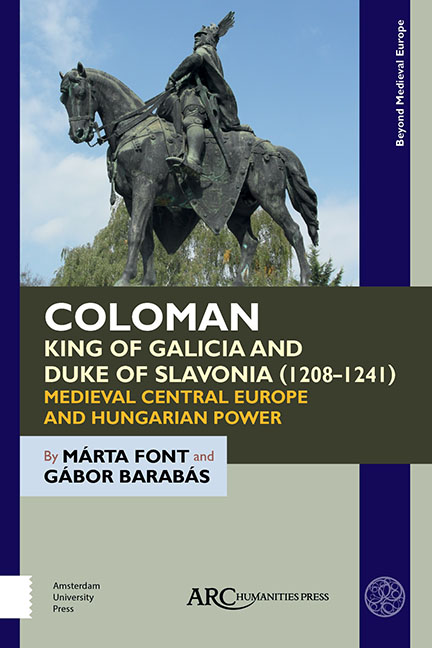 Coloman, King of Galicia and Duke of Slavonia (1208–1241)
Coloman, King of Galicia and Duke of Slavonia (1208–1241) Book contents
- Frontmatter
- Contents
- List of Illustrations
- Foreword
- Introduction
- PART ONE COLOMAN AS CHILD RULER OF GALICIA
- Chapter 1 The Galician Context in 1205
- Chapter 2 The Agreement of Scepus
- Chapter 3 Coloman’s Coronation as King of Galicia: Date and Place
- Chapter 4 The Hungarian Elite and Coloman’s Court
- Chapter 5 Coloman’s Position in Halych, 1215–22: Campaigns and Opponents
- Chapter 6 Upholding the Galician Claim: Coloman’s Place in Hungary
- PART TWO COLOMAN, DUKE OF WHOLE SLAVONIA (1226–1241)
- Chapter 7 Coloman and Scepus, Before 1226
- Chapter 8 Coloman as Duke of Whole Slavonia from 1226
- Chapter 9 Coloman’s Status and the Inner Workings of the Duchy
- Chapter 10 Coloman’s Ecclesiastical and Secular Actitivities in Slavonia
- Chapter 11 Coloman’s Rule in Slavonia
- Chapter 12 Politics and Dynastic Affairs
- Chapter 13 Challenges in the Balkans
- Chapter 14 The Mongol Attack and Coloman’s Death
- Conclusion: Coloman in the Eyes of Posterity
- Bibliography
- Index
Chapter 9 - Coloman’s Status and the Inner Workings of the Duchy
Published online by Cambridge University Press: 20 November 2020
- Frontmatter
- Contents
- List of Illustrations
- Foreword
- Introduction
- PART ONE COLOMAN AS CHILD RULER OF GALICIA
- Chapter 1 The Galician Context in 1205
- Chapter 2 The Agreement of Scepus
- Chapter 3 Coloman’s Coronation as King of Galicia: Date and Place
- Chapter 4 The Hungarian Elite and Coloman’s Court
- Chapter 5 Coloman’s Position in Halych, 1215–22: Campaigns and Opponents
- Chapter 6 Upholding the Galician Claim: Coloman’s Place in Hungary
- PART TWO COLOMAN, DUKE OF WHOLE SLAVONIA (1226–1241)
- Chapter 7 Coloman and Scepus, Before 1226
- Chapter 8 Coloman as Duke of Whole Slavonia from 1226
- Chapter 9 Coloman’s Status and the Inner Workings of the Duchy
- Chapter 10 Coloman’s Ecclesiastical and Secular Actitivities in Slavonia
- Chapter 11 Coloman’s Rule in Slavonia
- Chapter 12 Politics and Dynastic Affairs
- Chapter 13 Challenges in the Balkans
- Chapter 14 The Mongol Attack and Coloman’s Death
- Conclusion: Coloman in the Eyes of Posterity
- Bibliography
- Index
Summary
IN THIS CHAPTER we will examine Coloman's titles and what they say about the territory over which he ruled, before going on to examine the structures of government: the court, chancery, treasury, and
Coloman's Titles
To understand the various titles used in historical documents to describe Coloman, let us first turn to the letters written by his father and older brother and the formulations used in them, and then turn to the duke's own charters and papal diplomas.
In the first record, a charter of Andrew II sent to Pope Innocent III in 1214, Coloman is mentioned only as the son of the Hungarian king. But after his coronation in Halych, he was referred to as king in every single case. We know, however—as with Béla too—of examples in which, beside the royal title, the title of Coloman as the duke of Dalmatia and Croatia (a title acquired from his father), was emphasized. This is perhaps not so surprising since in this case Andrew II was confirming his son's donation to the bishop of Trogir on the Dalmatian coast. In other records—beside his title as king—Coloman was referred to simply as the duke of whole Slavonia. This may be important in the light of the papal letters, as we will see later.
Let us also recall a donation of Andrew II in 1234 in which Coloman—as with the practice of the Holy See—was mentioned as illustris rex. In princely or royal charters issued by Béla, written by Béla concerning the support from his brother during the investigations into the royal grants, besides clearly expressing their fraternal connection, Coloman was named illustrious king in royal and papal letters alike. The title duke of whole Slavonia appeared too, and it was so frequent that after the beginning of Béla's rule the expression beloved brother, King Coloman, the duke of whole Slavonia came into general use.
The first known charter by Coloman was issued in 1226, and it is remarkable in itself, since we find a relatively complex intitulatio, perhaps influenced by the aforementioned inscription of Andrew II.
- Type
- Chapter
- Information
- Coloman, King of Galicia and Duke of Slavonia (1208–1241)Medieval Central Europe and Hungarian Power, pp. 79 - 90Publisher: Amsterdam University PressPrint publication year: 2019


